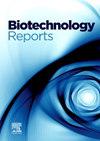海藻酸盐- pva -铜绿假单胞菌生物复合材料去除亚甲基蓝:动力学和生物降解研究
Q1 Immunology and Microbiology
引用次数: 0
摘要
亚甲基蓝(MB)是一种常用的合成染料,因其含量丰富且具有成本效益而广泛应用于各个工业领域。然而,这种合成染料在工业废水中的存在,当排放到土壤或水体中时,有可能对环境和公众健康造成重大影响。结果表明,废水生物处理因其经济可行性、效率和环境相容性而成为一种很有前途的方法。因此,本研究旨在评价在海藻酸-聚乙烯醇(PVA)基质中固定化铜绿假单胞菌对MB的去除效果,并将其与游离(未固定化)细胞的去除效果进行比较。结果表明,固定化铜绿假单胞菌(Alg-PVA- pa珠粒)对MB的去除率(72.52%)高于游离细胞(55.52%)和单独的Alg-PVA珠粒(43.12%)。吸附分析表明,去除过程符合准二级动力学模型,表明是化学吸附,Langmuir等温线最能描述去除过程,表明是单层吸附。此外,重复使用试验表明,在连续5个循环后,固定化生物复合微球的MB去除效率仍保持在35%以上,表明微球的可持续性。XRD, FTIR和SEM-EDX分析证实了P. aeruginosa在Alg-PVA基质中的成功捕获,并显示了MB去除过程后珠粒的结构变化。LC-QTOF/MS结果也支持了这一结果,代谢产物的保留时间分别为1.17、1.52、8.35和9.36 min,表明MB成功降解。本文章由计算机程序翻译,如有差异,请以英文原文为准。
Methylene Blue Removal Using Alginate-PVA-Pseudomonas aeruginosa Biocomposite: Kinetics and Biodegradation Studies
Methylene blue (MB) is a common synthetic dye used in various industries due to its abundance and cost-effectiveness. However, the presence of this synthetic dye in industrial wastewater has the potential to cause significant effects on the environment and public health when released into soil or water bodies. According to results, biological wastewater treatment has emerged as a promising approach due to its economic feasibility, efficiency, and environmental compatibility. Therefore, this study aims to evaluate the MB removal by Pseudomonas aeruginosa immobilized within alginate–polyvinyl alcohol (PVA) matrices and compare removal performance to that of free (non-immobilized) cells. The results showed that the immobilized P. aeruginosa (Alg-PVA-PA beads) exhibited higher MB removal efficiency (72.52%) compared to free cells (55.52%) and Alg-PVA beads alone (43.12%). Adsorption analysis showed that the removal process followed a pseudo-second-order kinetic model, suggesting chemisorption, and was best described by the Langmuir isotherm, showing monolayer adsorption. Additionally, reusability tests showed that the immobilized biocomposite beads retained over 35% MB removal efficiency after five consecutive cycles, suggesting the sustainability of the beads. XRD, FTIR, and SEM-EDX analysis confirmed the successful entrapment of P. aeruginosa within the Alg-PVA matrices and showed structural changes in the beads following the MB removal process. The results were also supported by LC-QTOF/MS outcomes, which showed metabolites with retention times of 1.17, 1.52, 8.35, and 9.36 min, suggesting the successful degradation of MB.
求助全文
通过发布文献求助,成功后即可免费获取论文全文。
去求助
来源期刊

Biotechnology Reports
Immunology and Microbiology-Applied Microbiology and Biotechnology
CiteScore
15.80
自引率
0.00%
发文量
79
审稿时长
55 days
期刊介绍:
Biotechnology Reports covers all aspects of Biotechnology particularly those reports that are useful and informative and that will be of value to other researchers in related fields. Biotechnology Reports loves ground breaking science, but will also accept good science that can be of use to the biotechnology community. The journal maintains a high quality peer review where submissions are considered on the basis of scientific validity and technical quality. Acceptable paper types are research articles (short or full communications), methods, mini-reviews, and commentaries in the following areas: Healthcare and pharmaceutical biotechnology Agricultural and food biotechnology Environmental biotechnology Molecular biology, cell and tissue engineering and synthetic biology Industrial biotechnology, biofuels and bioenergy Nanobiotechnology Bioinformatics & systems biology New processes and products in biotechnology, bioprocess engineering.
 求助内容:
求助内容: 应助结果提醒方式:
应助结果提醒方式:


